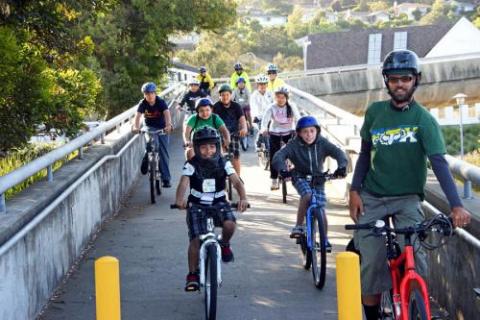
An interview with James Sievert, a Teacher for Marin County SR2S
Tell us a little about yourself.
In college, I studied elementary education. In the same year I started to get around by bicycle, I was hit by a driver and hurt my leg. It got me into advocacy, making me look into: “Is it safe to ride a bike?” and “How can I make it safer?” That was in 2005. It still has been ongoing on a daily basis.
That’s also when I found out about Safe Routes, a great way to combine street safety and elementary education. Once I volunteered at the local Bike Rodeo, I was hooked. After graduating, I applied to SR2S programs all over the Bay Area. I landed in the Marin SR2S program and was happy because the program had been around for a decade and covered all aspects: education, enforcement, encouragement, and engineering. In 2010, I started as an instructor. This year will be my fifth year teaching pedestrian safety to younger elementary students, and bicycle training for students 4th grade and up. We reach over 50 schools in a year, so 5,000 students.
Have you had to overcome any barriers in reaching and/or making an impact in your community? How did you overcome them?
When you’re teaching safety information, there’s a tendency to focus on injury and what bad things could happen. It creates mixed messaging. It’s important to empower students instead of teaching them to be afraid of getting hurt. You want to provide an environment where students are excited to learn. You can’t teach everything about traffic safety in one hour, but you can get them excited about participating in transportation of all kinds. In terms of teaching, and having a background as a California credential teacher, it is something I bring [to Safe Routes] and am happy to work on. I am always pushing for lesson planning classes that are fun, interactive and providing important information.
What excites or inspires you about your work?
What’s inspiring is that I see someone get better almost every month: new schools increasing in walking biking or carpool numbers; you see volunteers’ growing efforts – we just had International Walk and Roll to School Day, and you would see law enforcement getting into it – with kids, you see smiles. It’s just so great to catch them [students] when they’re biking or walking not for an event. It’s fantastic to see someone on a Tuesday walking or biking. Acknowledging that is an important act. For a lot of students, I can really give them their kudos. It makes it special.
Tell us about a funny/interesting story from your work.
A student who is now in his freshman year of college volunteered in his senior year of high school. He had regularly interacted with the program since 2nd grade. There is a lasting impact that our program has had. When this person thinks about traffic safety as an adult, they will already be onboard with the program. It’s great to see the graduates of the program come back full circle.
Are there any resources that have been particularly helpful to you?
Before getting a job here, I visited our Marin Safe Routes website. Marin SR2S was one of the earlier programs, and the website explains the SR2S history and movement.